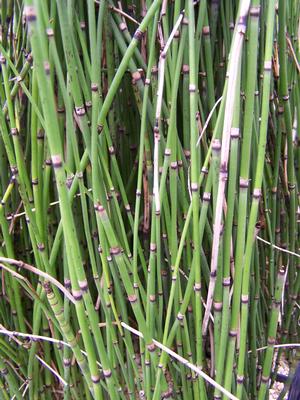View All Plants :: View All GRASSES & GRASS-LIKE PLANTS :: View All POND & WETLAND PLANTS :: View All SUN PERENNIALS
Equisetum hyemale
Giant Horsetail
Plant Type:
GRASSES & GRASS-LIKE PLANTSEquisetum hyemale – This horsetail is the Winter Scouring Rush. It has also been referred to as the Giant Horsetail. It is a curiously beautiful primitive plant with segmented stems that make one think “bamboo!” Horsetails benefit greatly when silicon is amended into the soil; in fact, it is an essential nutrient for them. Peat and bark based blends contain little silicon and Equisetum tend to languish in these mixes. We recently discovered this truth when our crop began to languish in containers... we're never too old to learn! Equisetum hyemale enjoys moist to wet sites in part to full sun where it will attempt colonization. We have seen this tendency smartly foiled when planted on a small island in the middle of a water garden in Japanese gardening. Could be well-used in a moist garden setting or potted in stark contrast other potted flowering or bold-foliaged plants of different colors.
For researchers and wildlife reclamation scientists who require a large number please ccontact us at (860) 779-1732 or email at wayne@quackingrassnursery.com so that we can better accommodate your specific needs.
Height:
2-4 ftCharacteristics and Attributes for Equisetum hyemale
Season of Interest (Foliage)
- Spring / Summer / into Autumn
Nature Attraction
- Deer Resistant
Light
- Sun Tolerant
- Morning Sun / Afternoon Shade
Attributes
- Massing
- Natural Garden
- Potted Plant
- Specimen
- Bog
- Foliage
- Wildlife Garden
- Ground Cover
- Marginal
Growth Rate in the Garden
- Moderately Fast
Soil
- Wet
- Adaptable
Origins
- Eurasia
- North America
Propagated By
- Division
Genus Overview: Epimedium
The Barrenworts have received much attention in recent years and deservedly so. They come in many differently-colored flowering forms sporting delicate, dangling spider-like blossoms in spring. Some, as in E. sempervirens, are virtually evergreen; many others deciduous with delicate kidney-shaped leaves on wiry stems. The foliage on many cultivars in our USDA zone 5b (-15F) remains handsome until the winter solstice supplying 2 to 3 seasons of interest, some even provide golden to purple-bronze autumn tones. Slowly, gradually, they form a ground cover in part to full, open shade in fertile soil. The Barrenworts or Bishop Hats exhibit fair drought tolerance and are well-behaved members in part to open shade. They work well in herbaceous borders, woodland gardens or down-facing shrubs. Epimediums are members of the Berberidaceae and are of Asian origin. Once established they exhibit fair tolerance to dry shade. All of the following are pot-grown divisions from our plants.
